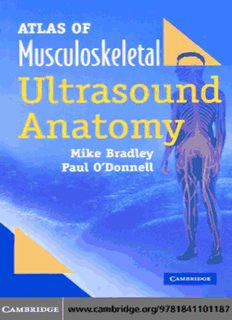
Atlas of musculoskeletal ultrasound anatomy PDF
Preview Atlas of musculoskeletal ultrasound anatomy
Prelims.qxd 31/Aug/02 4:26 PM Page i Atlas of musculoskeletal ultrasound anatomy Prelims.qxd 31/Aug/02 4:26 PM Page ii Prelims.qxd 31/Aug/02 4:26 PM Page iii Atlas of musculoskeletal ultrasound anatomy Dr Mike Bradley, FRCR Consultant Radiologist, North Bristol NHS Trust, Honorary Senior Lecturer, University of Bristol Dr Paul O’Donnell, FRCR Consultant Radiologist, Royal National Orthopaedic Hospital, Stanmore, Middlesex LONDON SAN FRANCISCO cambridge university press Cambridge, New York, Melbourne, Madrid, Cape Town, Singapore, São Paulo Cambridge University Press The Edinburgh Building, Cambridge cb2 2ru, UK Published in the United States of America by Cambridge University Press, New York www.cambridge.org Information on this title: www.cambridge.org/9781841101187 © Greenwich Medical Media Limited 2002 This publication is in copyright. Subject to statutory exception and to the provision of relevant collective licensing agreements, no reproduction of any part may take place without the written permission of Cambridge University Press. First published in print format 2004 isbn-13 978-0-511-19612-6 eBook (NetLibrary) isbn-10 0-511-19612-1 eBook (NetLibrary) isbn-13 978-1-841-10118-7 paperback isbn-10 1-841-10118-4 paperback Cambridge University Press has no responsibility for the persistence or accuracy of urls for external or third-party internet websites referred to in this publication, and does not guarantee that any content on such websites is, or will remain, accurate or appropriate. Prelims.qxd 31/Aug/02 4:26 PM Page v Contents Preface – technology introduction vii Principles and pitfalls of musculoskeletal ultrasound ix Echogenicity of tissues xi Chest 1 Supraclavicular fossa 2 Infraclavicular fossa 8 Sternoclavicular joint 10 Chest wall 12 Axilla 22 Upper limb 27 Shoulder 28 Upper arm 46 Elbow 50 Forearm 72 Wrist 82 Hand 96 Abdomen and pelvis 115 Anterior wall 116 Posterior wall 126 Groin 134 Hip 146 Lower limb 171 Thigh 172 Knee 184 Calf 214 Ankle 224 Foot 244 v Prelims.qxd 31/Aug/02 4:26 PM Page vi Prelims.qxd 31/Aug/02 4:26 PM Page vii Preface – technology introduction P r e f a c e The images in the current text were achieved using an ATLHDI 5000 SonoCT – ultrasound system (Advanced Technology Laboratories, Bothwell, WA) te c coupled with an L12–5MHz footprint linear array transducer. Astand-off pad h n was not used, but liberal amounts of coupling gel was applied. o l o g Most of the images displayed were obtained using ATL’s patented SonoCT y i real-time compound imaging technology. This technology is distinct from n t r conventional ultrasound in that it obtains images from multiple lines of sight. o d In real-time compounding, ultrasound beams are steered from up to nine lines u c of sight and are combined into a single image at real-time frame rates. This t i o allows all structures to be scanned at a plane that is at or close to 90° to one or n more of the scan lines. It is distinct from other compounding methods, in that it uses computed transmit-and-receive functions to form a compound image in real time. This technology can dramatically suppress or eliminate many routine problems that degrade ultrasound images, such as noise, speckle, clutter and image artefacts. In addition, contrast resolution is enhanced improving diagnostic confidence. Recently, ATLhave introduced SonoCT Imaging achieving a breakthrough in panoramic image quality. ATLuses patented pattern recognition technology, instead of matching pixels along the edge of an image to generate a panoramic appearance. Panoramic SonoCT relies on processing tissue patterns captured from a region of interest. This real-time pattern recognition method makes it easier and faster to perform panoramic scanning because it is less dependent on the user maintaining a steady and smooth sweep. It also enables the user to easily reverse direction without restarting a panoramic scan. vii Prelims.qxd 31/Aug/02 4:26 PM Page viii Prelims.qxd 31/Aug/02 4:26 PM Page ix Principles and pitfalls of P r i n musculoskeletal ultrasound c i p l e s a High resolution– best results are obtained using a high frequency linear n d probe on a matched ultrasound system. Power Doppler is often helpful for p i pathological diagnosis as well in the identification of normal anatomy. tf a l l s Anisotropy– this phenomenon produces focal areas of hypo-echogenicity o when the probe is not at 90 degrees to the linear structure being imaged. This f m is particularly noticeable when imaging tendons resulting in simulation of u s hypo-echoic pathological lesions within the tendon. The sonographer can c u compensate for this by maintaining the 90-degrees angle or by using lo s compound imaging. k e l e Anatomy– knowledge of the relevant anatomy is essential for accurate ta l diagnosis and location of disease. u l t r a Symmetry– The sonographer can often compare anatomical areas for s o symmetry helping to diagnose subtle echographic changes. u n d Dynamic– ultrasound successfully lends itself to scanning whilst moving the relevant anatomy, either passive or resistive. This can help to demonstrate abnormalities which may be accentuated by movement. Palpation– the sonographer has the opportunity to palpate the abnormality or anatomy linking the imaging directly with the symptomatology, in a manner not possible with other types of cross-sectional imaging. ix
Description: